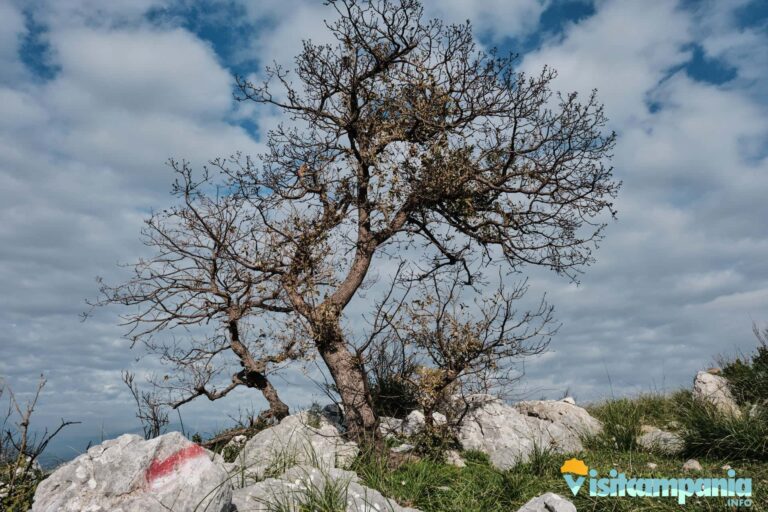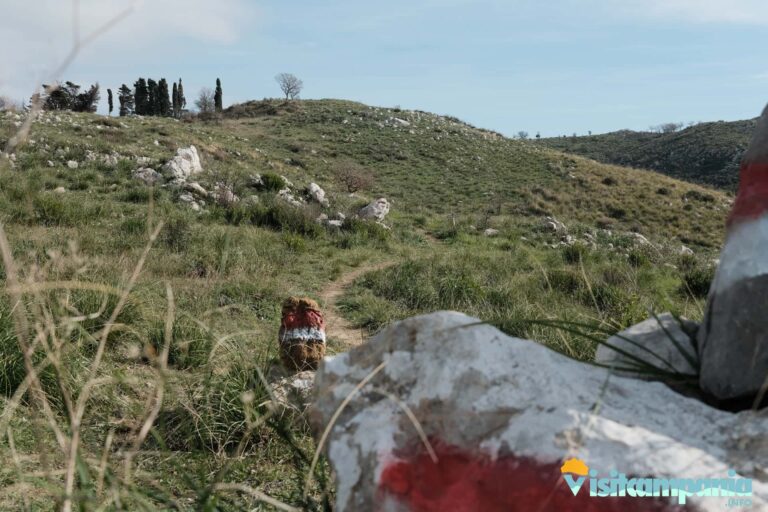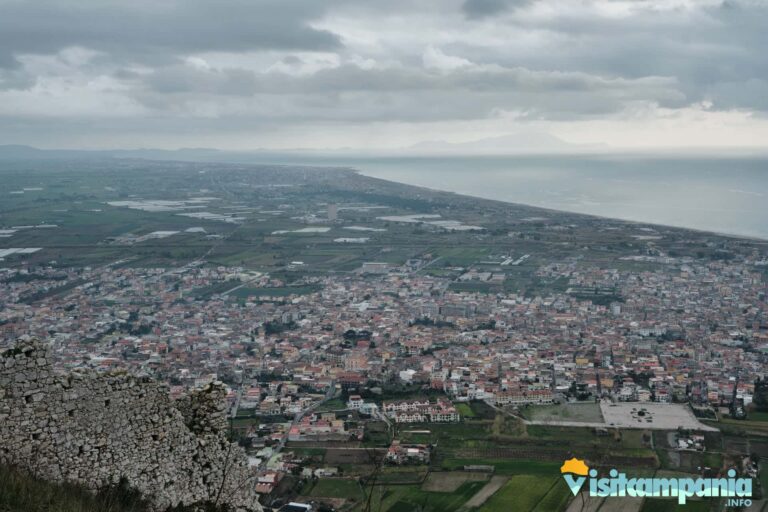Mondragone, Monastero Sant’Anna de aquis vivis, Rocca Montis Dragonis and back (Sentiero degli Dei Casertano)
The well-marked path that leads from the Monastery of Sant’Anna de aquis vivis, on the Mount Crestagallo, leads to the Rocca Montis Dragonis, on Mount Petrino, is also known as the path of the Caserta Gods and unfolds in the territory of the municipality of Mondragone. The variant that we propose here starts, in reality, almost 1.5 km before the Monastery. In fact, we leave the cars about halfway along the paved road that from the Belvedere church, downstream, climbs up Mount Crestagallo, following it until we meet the bar that closes the passage. We then begin the ascent by continuing along the paved road from which we can already admire the view of the Domitio coast, a panorama that will accompany us pleasantly throughout the journey. 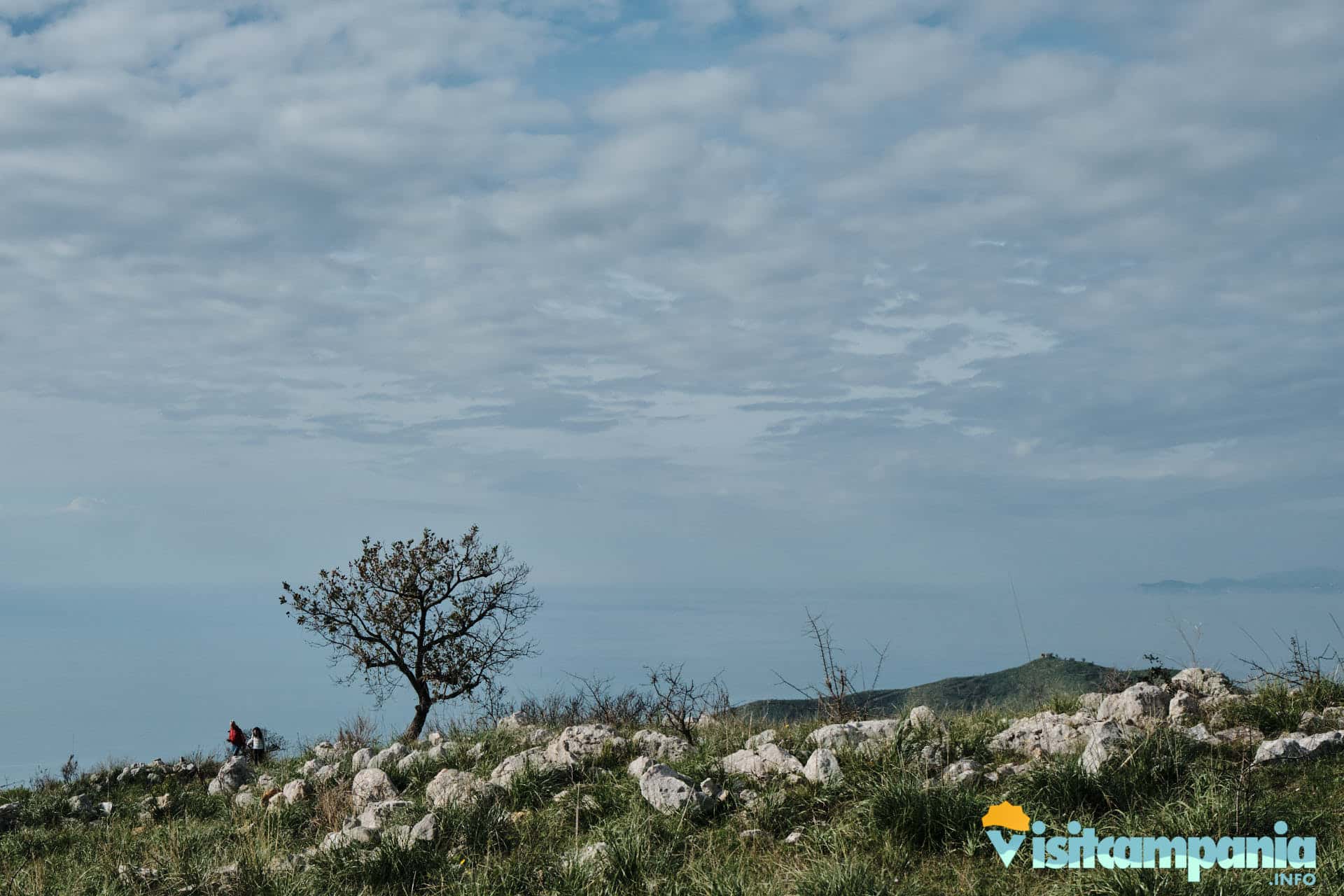
The Monastery of Sant’Anna de aquis vivis
After about a kilometer and a half of agile ascent and immediately after the end of the asphalted stretch, we arrive at the ruins of the Monastery of Sant’Anna de aquis vivis dating back to the fourteenth century in its original layout. The settlement was born with the construction of humble cells by a few hermits who had moved to this place towards the end of the thirteenth century AD. Within a few years a small church dedicated to St. Anne was built. However, the first important step for the development of the settlement was the donation, in 1325 , of a large plot of land to hermits by the Queen consort of Naples, Sancha of Aragon wife of Robert of Anjou. With the increase in the number of hermits, the growing community decided, first, to affiliate with the religious order of the Benedictines and, in 1342, to expand the original settlement with the construction of a real monastery. With the development of the town in the flat part of the territory, the Monastery began a slow but steady decline to which not even the recovery works begun in the 2000s but never finished have put no brakes.  Today the structure is substantially abandoned. Only the church, which is accessed through an imposing stone arch, still preserves sufficient vestiges of the ancient structure with its Latin cross plan, a single nave and three apses. Flowers, sacred ornaments and old photos testify that the place is still lived by the faithful. In addition, the remains of the monastery are still visible and here and there it is possible to identify the plan of the cloister and other buildings that made up the complex. Not far from the monastery, beyond the apse of the church, stands the dovecote, a tower-shaped structure used for breeding pigeons. Nearby there is also a water collection basin from a perennial spring that gives its name to the monastery (de aquis vivis or living water) and to which miraculous properties are attributed.
Today the structure is substantially abandoned. Only the church, which is accessed through an imposing stone arch, still preserves sufficient vestiges of the ancient structure with its Latin cross plan, a single nave and three apses. Flowers, sacred ornaments and old photos testify that the place is still lived by the faithful. In addition, the remains of the monastery are still visible and here and there it is possible to identify the plan of the cloister and other buildings that made up the complex. Not far from the monastery, beyond the apse of the church, stands the dovecote, a tower-shaped structure used for breeding pigeons. Nearby there is also a water collection basin from a perennial spring that gives its name to the monastery (de aquis vivis or living water) and to which miraculous properties are attributed.
On the way to the Secret Garden
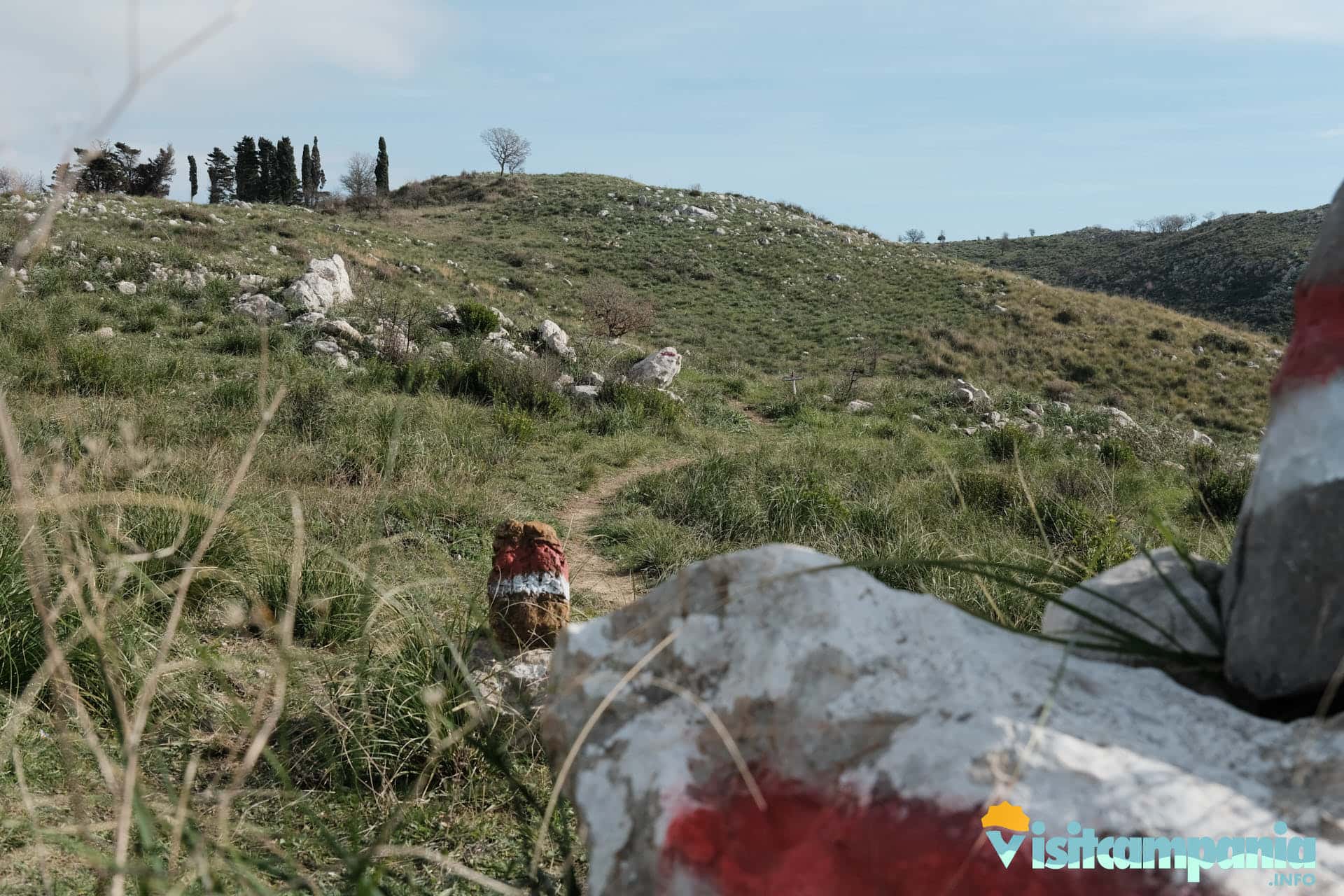 After the visit of the monastic complex, or rather of what remains of it, we continue our walk along the path of the Caserta Gods. We take the dirt path to the left of the convent and continue the ascent of Mount Crestagallo. Now the slope is greater but never particularly difficult. About a kilometer of dirt and stone road separates us from the next stop, the Secret Garden. The place, clearly indicated by a sign, consists of a small plateau in which cypresses and other trees stand out in a substantially barren landscape. The view ranges from the Gulf of Gaeta on the right to Vesuvius on the left and dominates the entire Domitian coast. The profile of Ischia, like a mermaid lying on the sea, is right in front of us. It is easy, therefore, to understand why the monks went here to meditate and devote themselves to the cultivation of herbs. We make a short stop to refresh ourselves and resume our journey.
After the visit of the monastic complex, or rather of what remains of it, we continue our walk along the path of the Caserta Gods. We take the dirt path to the left of the convent and continue the ascent of Mount Crestagallo. Now the slope is greater but never particularly difficult. About a kilometer of dirt and stone road separates us from the next stop, the Secret Garden. The place, clearly indicated by a sign, consists of a small plateau in which cypresses and other trees stand out in a substantially barren landscape. The view ranges from the Gulf of Gaeta on the right to Vesuvius on the left and dominates the entire Domitian coast. The profile of Ischia, like a mermaid lying on the sea, is right in front of us. It is easy, therefore, to understand why the monks went here to meditate and devote themselves to the cultivation of herbs. We make a short stop to refresh ourselves and resume our journey.
Continue towards Campetto
Resumed the journey we cross a small valley that a sign informs us to be called the Asphodels. In just over half a kilometer we arrive at the top of another hill, the highest point of the route, from which it is possible to reappear on the coast. For the avoidance of doubt, a sign says “panoramic terrace” and it is difficult to blame him. Moreover, from here, it is possible to follow with your eyes almost all the three kilometers that still separate us from the Rocca, clinging to Mount Petrino.

We continue the journey following the signs for “i Pini” and “Campetto”. Now the path is all downhill, more or less stony. Let’s follow the hairpin bends until we see, on our left, a semi-abandoned house and, further away, a stretch of paved road. This is locality Campetto. Let’s reach it keeping to the left and prepare for the final climb on the slopes of Mount Petrino.
At the top of Mount Petrino and the Rocca Montis Dragonis
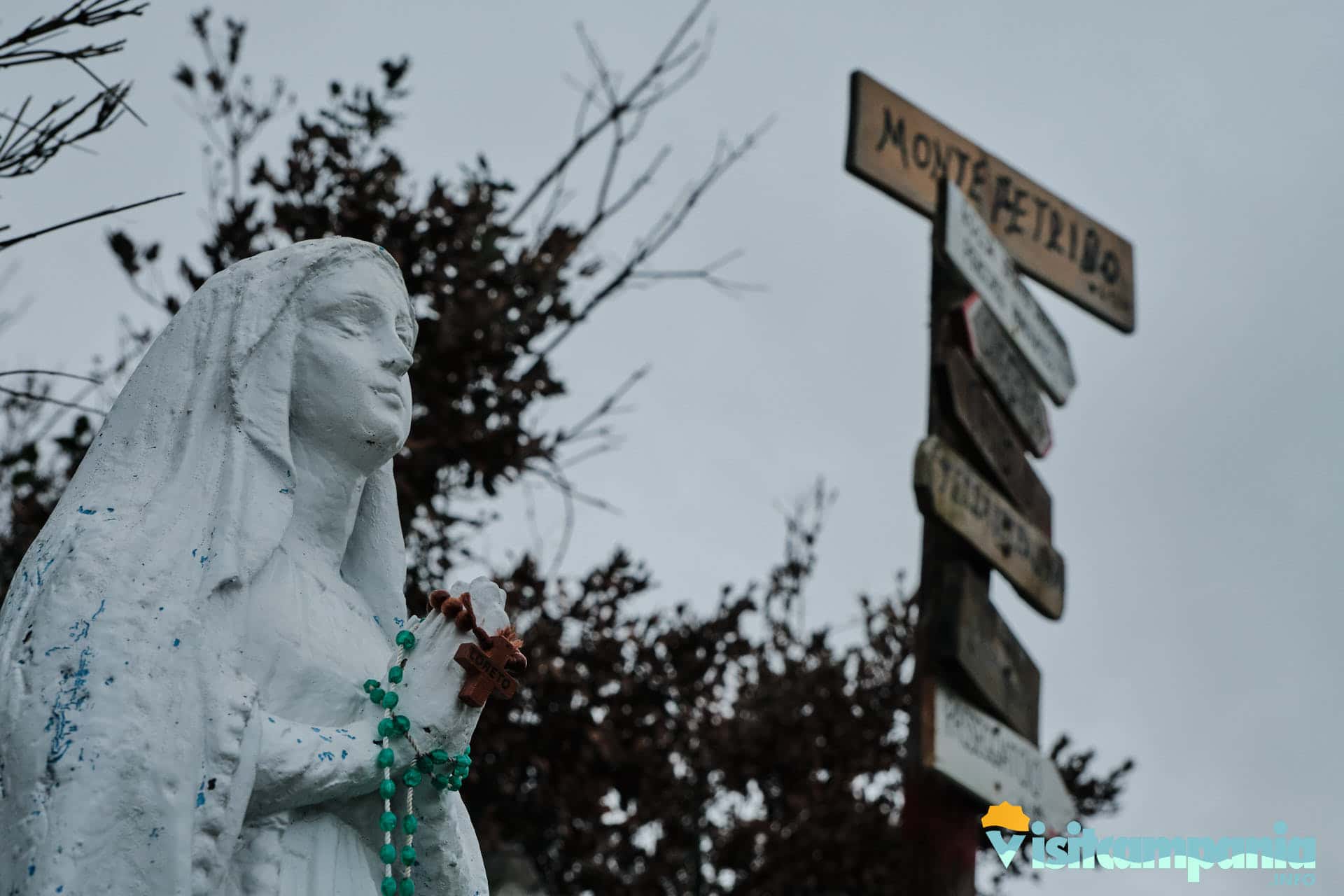 The climb of Mount Petrino is quite easy even after the 5 km already covered. It is about a kilometer long and the steepest stretch is the last 500 meters already inside the first city walls. The Montis Dragonis Rock is, in fact, huge. Although it is in a state of abandonment and rather pronounced degradation,sections of the three walls that surrounded it are still visible, as well as a circular tower, remains of the imposing main building and then cisterns and other scattered remains. Generally the complex is accessible but the state of neglect and the presence of numerous cisterns recommend attention. We follow the signs in red paint and keep our eyes open.
The climb of Mount Petrino is quite easy even after the 5 km already covered. It is about a kilometer long and the steepest stretch is the last 500 meters already inside the first city walls. The Montis Dragonis Rock is, in fact, huge. Although it is in a state of abandonment and rather pronounced degradation,sections of the three walls that surrounded it are still visible, as well as a circular tower, remains of the imposing main building and then cisterns and other scattered remains. Generally the complex is accessible but the state of neglect and the presence of numerous cisterns recommend attention. We follow the signs in red paint and keep our eyes open. 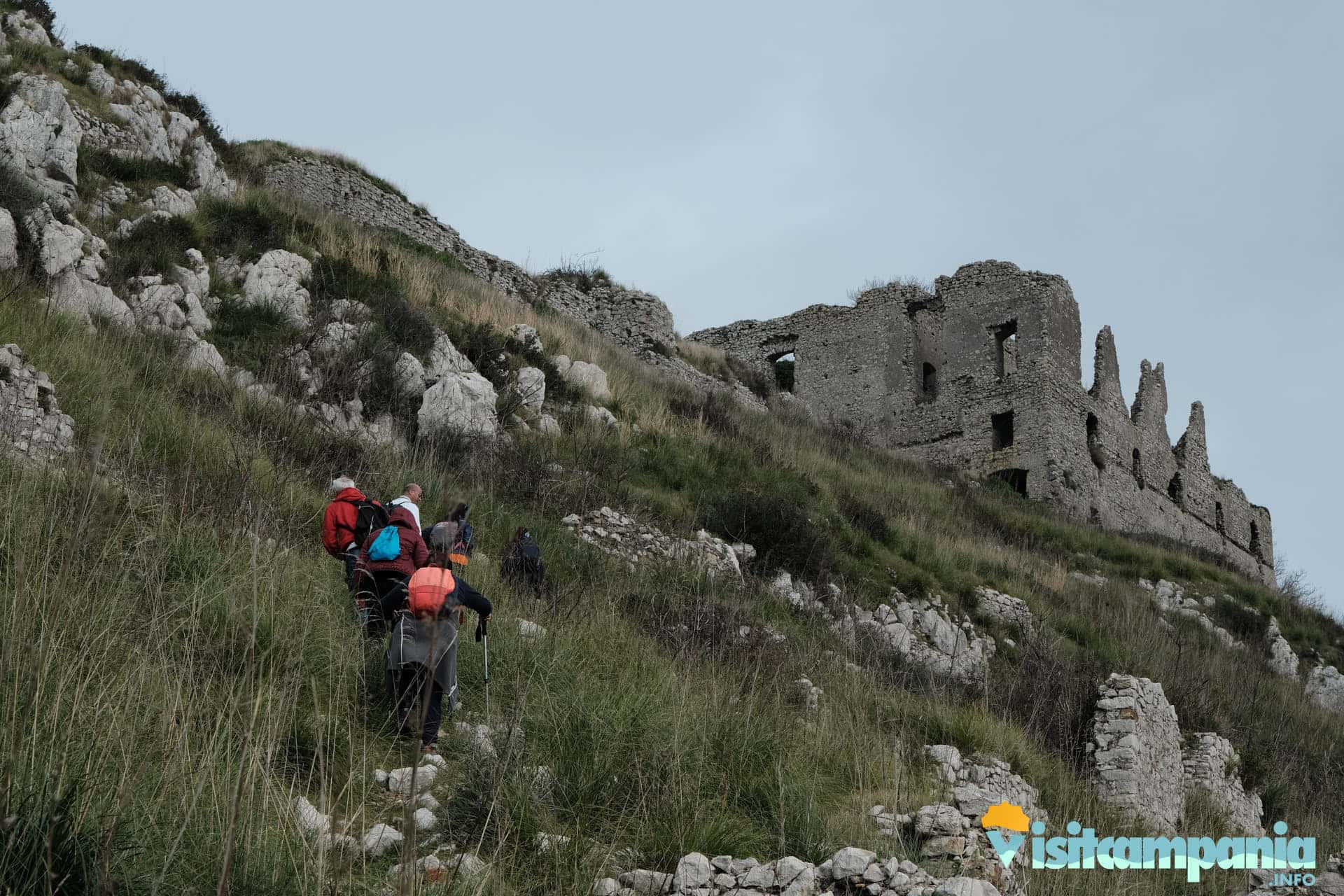 The archaeological excavations, the most important carried out between 2003 and 2009, have brought to light the three main settlements that form the Rocca. The first consists of the large building still clearly visible on the top of the mountain and a large courtyard on which smaller structures insisted. It is enclosed by a first wall which includes a circular tower. On the eastern side, then inland, a small village was found with a small church with a single nave also enclosed by further walls. On the south side, finally, another village was found. The whole vast complex is surrounded by a third line of fortifications of which only a few very impressive sections remain.
The archaeological excavations, the most important carried out between 2003 and 2009, have brought to light the three main settlements that form the Rocca. The first consists of the large building still clearly visible on the top of the mountain and a large courtyard on which smaller structures insisted. It is enclosed by a first wall which includes a circular tower. On the eastern side, then inland, a small village was found with a small church with a single nave also enclosed by further walls. On the south side, finally, another village was found. The whole vast complex is surrounded by a third line of fortifications of which only a few very impressive sections remain.
Some historical notes on the Montis Dragonis Rock
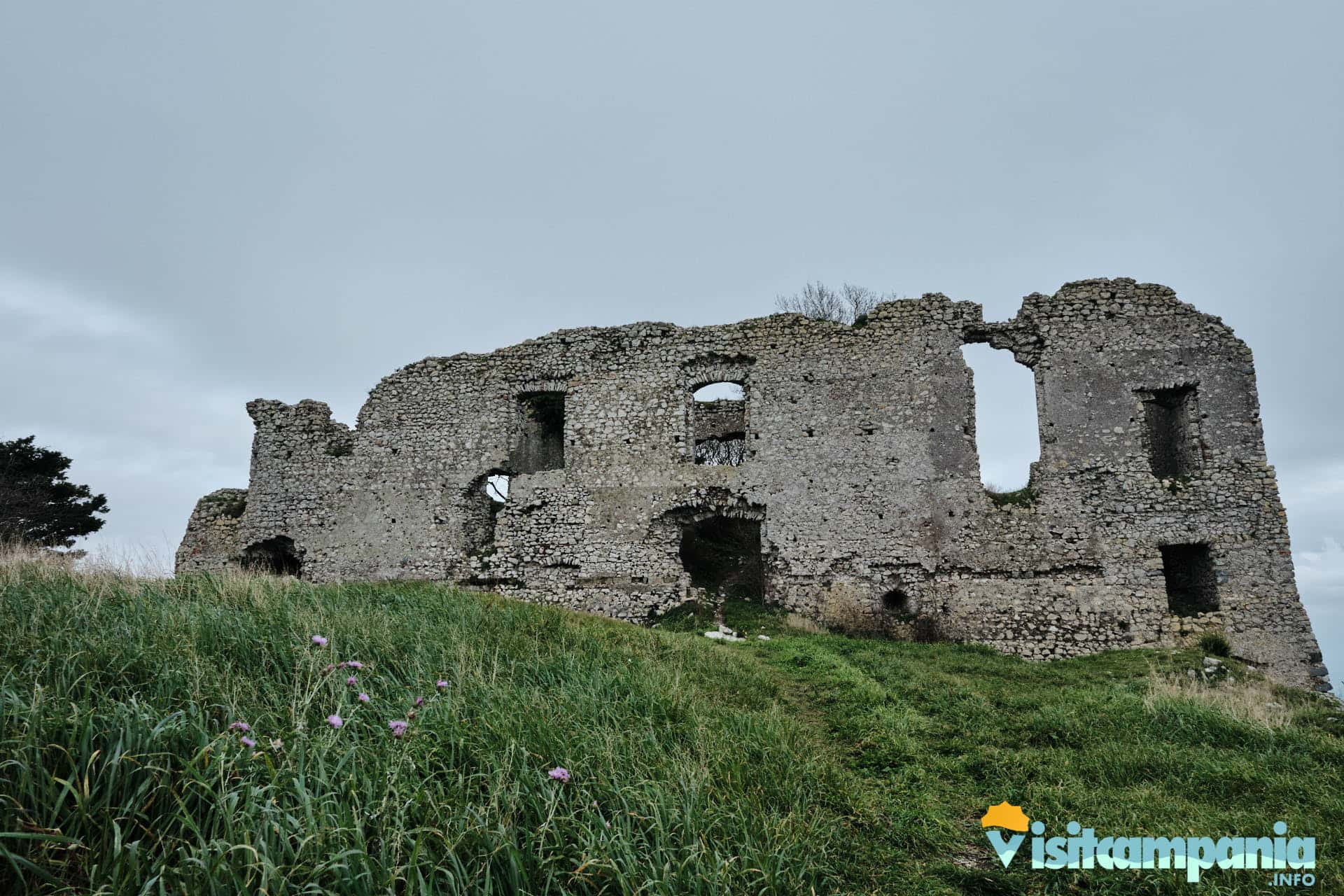 The history of the settlement is very ancient. In fact, well before the birth of the medieval castle, there was already a settlement called the village of the Cyclamen. We are between the ninth and seventh centuries BC. Subsequently, it was the inhabitants of the nearby Roman colony of Sinuessa who moved to Mount Petrino following the fall of the Empire. The first construction of the fortified area is due, however, to the Lombards of Capua in the tenth century AD. Between one expansion and another, the Rocca Montis Dragonis with its villages has crossed all the dynasties and dominations that have characterized the history of Naples and southern Italy. So, after the Lombards, came the Normans, then the Swabians, then the Angevins and finally the Aragonese. It is under the latter that the fortress loses its strategic defensive importance easily imaginable given the position of control over the entire Domitian coast. So the inhabitants began to move to the underlying plain giving life to the village of Casale Sant’Angelo which then became Mondragone. Let’s get back to us and to our Path of the Gods Casertano. We take advantage of the large flat clearing right on the top of Mount Petrino, near the main building, to take a lunch break and refresh ourselves properly.
The history of the settlement is very ancient. In fact, well before the birth of the medieval castle, there was already a settlement called the village of the Cyclamen. We are between the ninth and seventh centuries BC. Subsequently, it was the inhabitants of the nearby Roman colony of Sinuessa who moved to Mount Petrino following the fall of the Empire. The first construction of the fortified area is due, however, to the Lombards of Capua in the tenth century AD. Between one expansion and another, the Rocca Montis Dragonis with its villages has crossed all the dynasties and dominations that have characterized the history of Naples and southern Italy. So, after the Lombards, came the Normans, then the Swabians, then the Angevins and finally the Aragonese. It is under the latter that the fortress loses its strategic defensive importance easily imaginable given the position of control over the entire Domitian coast. So the inhabitants began to move to the underlying plain giving life to the village of Casale Sant’Angelo which then became Mondragone. Let’s get back to us and to our Path of the Gods Casertano. We take advantage of the large flat clearing right on the top of Mount Petrino, near the main building, to take a lunch break and refresh ourselves properly.
And now the return on the path of the Caserta Gods
We take the road back by retracing the same route as the outward journey in the opposite direction. We descend from the Rocca to Campetto. From here, and for the next two kilometers to the panoramic terrace already encountered previously, only ascent awaits us. About 200 meters of altitude difference quite tiring. Then, having reached the 458 meters of the summit, only descent awaits us. Here is the secret garden and then the monastery of St. Anne. Finally, after the last asphalted hairpin bends, here we are again at the cars.




